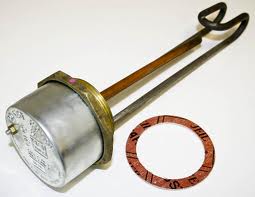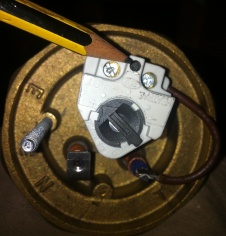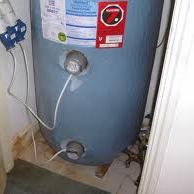Dangers
- Electrocution
- Flood
- Scalding
- Burns
- Flat blade screwdriver
- Cross head screwdriver
- Multimeter
- hammer
- immersion spanner If in doubt call a professional!!
Tools needed
Immersion elements
READ THE DANGERS SECTION
The idea of this is so you get an idea of your system, so you know if your engineer is doing his job correctly, if you attempt a repair yourself,be carefull

There are several types of these. basicaly they are - top entry, usualy 27 inches, side entry, mostly 11 inches (or 15 inches). They are made of either incalloy (hard water areas, or soft copper (soft water areas) The usual cause or breakage is scale on the element, wrong element type, or defective thermostat.
STEP 1

First thing, electricals. Power off, unscrew nut holding the cap and remove. Inside you have thermostat, earth stub, two element ends, overheat stat (sometimes built into stat). set your multimeter to 'continuity', and test across the thermostat, and overheat stat if you have one. Assuming the water is cold, there should be continuity. If not, try pressing the reset button on the overheat stat, see pic, two options, other type shown on burnt element lower down the page. NOTE - if you have to reset the overheat stat, turn the thermostat down a little, to stop it happening again. Assuming there is no continuity, replace stat - it can be withdrawn from its 'pocket' once the wiring is disconnected. Test the element across the two exposed element ends. 18 ohms is usualy it, short circuit or infinite resistance means blown. Also, put your multimeter to its highest resistance setting and test from each element end to the body of the element - earth, any resistance means the element jacket has a hole in it.
STEP 2

Assuming its busted, you now have to get it out. First job is to drain the tank. find the main feed pipe in - the one going into the lowest point of the cylinder. turn off the valve, and check that the hot taps no longer run - it will take a moment to stop. Now, you need to drain it. There is a drain valve low down on the cylinder. Connect a hose to this and unwind the shaft. Now, it should drain, but it wont...............
STEP 3,

Its usualy one of two things, a stuck drain valve washer, or scale in the cylinder. NOW PAUSE. Is the cylinder water cool? if not, wait till it is. Do you have plenty of towels ? if not get some. Where is your hose run to? it must run downhill all the time - if your in flats this usualy means out the front door, down the stairs and out a window on a lower level. Now get a small flatblade screwdriver, and a length of coathanger wire. unscrew the knurled cap that holds the drain valve shaft into the body, but leave the main valve stem in place. now unscrew the stem all the way out, and set aside, there will be some water coming out, but not a huge amount. Put your thumb over the end while finding the coat hanger and screwdriver. Look at the valve stem you have removed. Does it have a black rubber washer? if not, you need the screwdriver, if it does, the coathanger. If its the screwdriver, release thumb and quickly scrape out the washer, try getting at the outer edge and scraping it to the middle, not poking through the middle. Try doing it blind, holding a rag over the open end of the valve, so most of the water goes down the hosepipe. Once its out, the water will fly out! If your on coathanger duty, push it in, and wiggle it around to clear the blockage of debris.
STEP 4

Your now like the little boy in the dyke right? finger holding back a flood? ok, this is why we put the hosepipe downhill. If it has enough of a drop it will shortly start to syphon the water - loosen your finger off the end a bit and it will suck in air. Get your ptfe, wrap a turn or two around the removed valve stem thread, (you need at least 3 hands! - no seriously, hold the valve stem in your blocking hand, wrap tape with free hand) now whip your hand away and screw in the stem a few turns. All being well its tight enough not to leak. If it does, out it comes and more ptfe.
You will now expect it to drain quick..... It wont. you will hear a horrible sucking noise when its finished. Expect 40 minutes upwards.
STEP 5,

Ok, now to unscrew the immersion, just fit your spanner and turn anticlockwise...... Yeah right, try that, but it wont work! do not apply too much force! the cylinder is terribly thin, and now weighs very little. Try banging the handle with a hammer gently, or the heel of your palm. As this doesnt often work, go get your safety glasses, and a blowlamp. Cut out all the wiring, remove the stat, and heat the center of the immersion. DANGER! if you were wrong and its not a faulty element, or sometimes even when it is, the end of the element goes bang, blowing little bits of shrapnel all over. Its VERY loud and you will get blinded. Try to heat the center only, the insulation around the cylinder will very easily burn, so be careful. Its usualy cooked when tiny beads of solder appear around the thermostat pocket. Now unscrew it! BTW, if it wont heat up, however hard you try, its still full of water!
Once its out, cut the element off the threaded body, and use the body to clear out the threads, (screw it in/out to get the old sealant from the channels)
STEP 6,

Now we are ready to replace. Remember to choose the right element for your water type, and unpack it. Have a quick look at the washer... big thing, very tight to get over the threads..... till it gets to the bottom, then it flops all over the place. Heres what i do. wrap ptfe around the last few threads of the element, to centralise the washer. now apply a massive amount of sealing comound to both sides of washer. Now screw it in, and it should go all the way in by hand, till the washer touches the cylinder. now tighten it hard with the spanner - it shouldnt be much more than 1/2 turn.
STEP 7,

Now, to fill up. dont wire the element yet, dont remove the hosepipe. open the valve, let it fill a little and watch for leaks, if ok, fill more, check again, then fill totaly. The hose is there in case! Now, before you wire it in, nip it up a bit more, then wire it. The picture here shows what happens if the wires are not tightened properly.
Immersion Notes
- A top entry element only needs to be drained a little bit
- Modern cylinders are extremely thin. Be gentle
- If you cant get the element in all the way hand tight you WILL cross thread it
